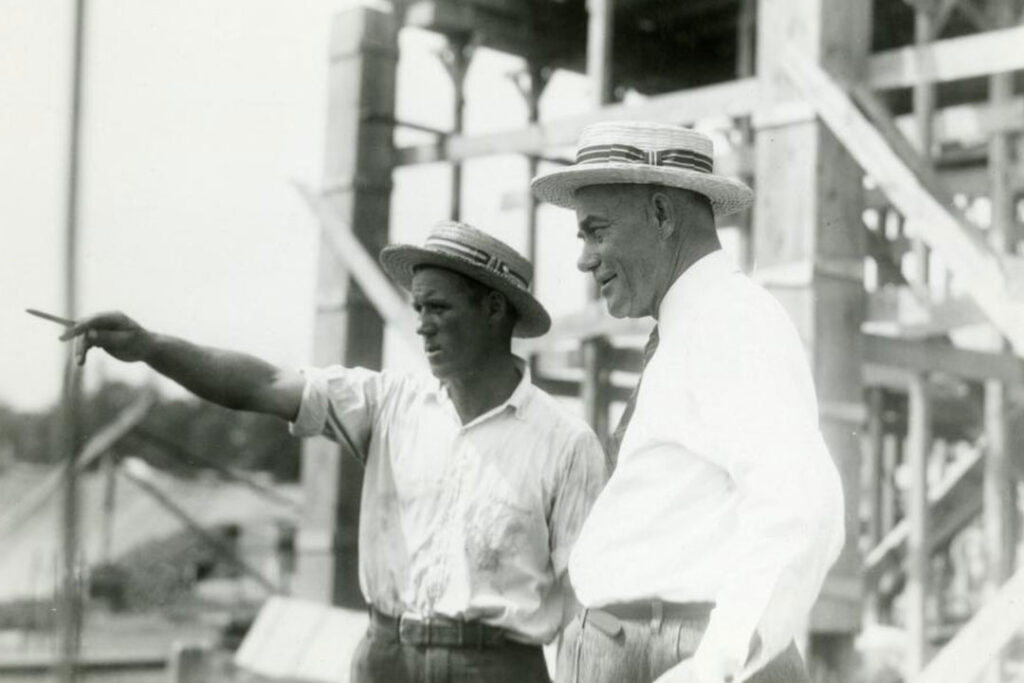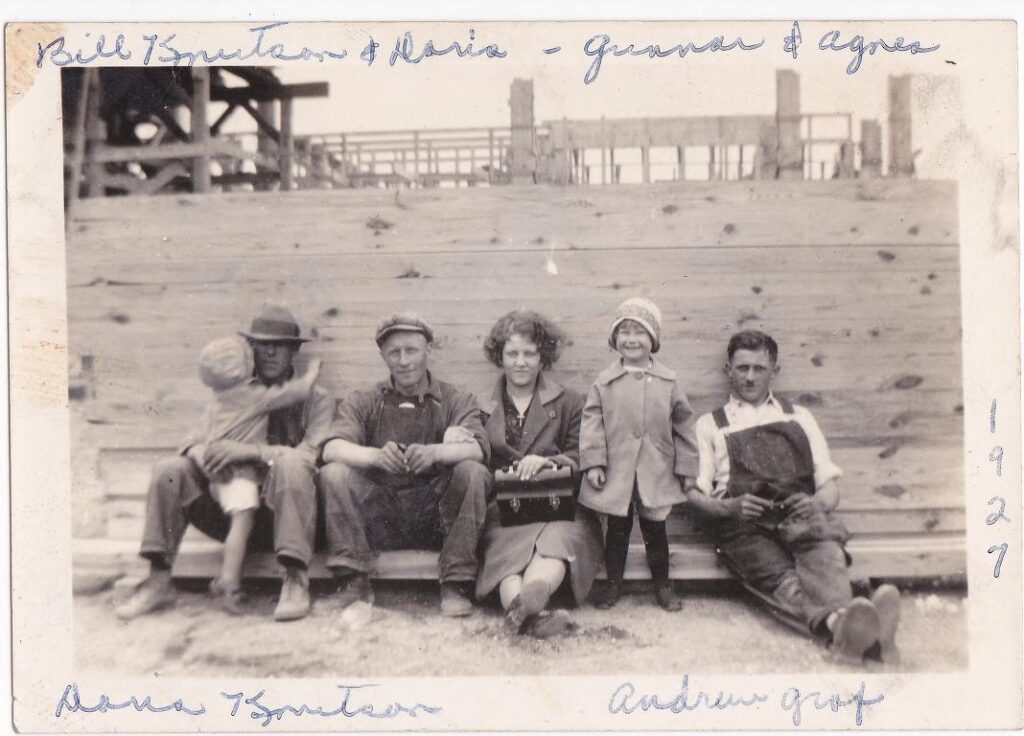Let the games begin
When construction crews broke ground on Michigan Stadium in September 1926, workers had to know they were on to something big. Literally. And now the gameday experience is about to get a lot more colorful, vivid, and immersive for fans in the stands as Michigan Athletics unveils two dazzling high-tech scoreboards. At 179 feet wide by 62 feet tall, the viewing area is 120 percent larger than before. On a much smaller scale, Michigan Today offers up this subdued analog version of the Big House’s inception. These images are courtesy of U-M’s Bentley Historical Library. Captions were sourced from “The Michigan Stadium Story” at the Bentley website. Click on any image to enlarge.
-
Visionary
Michigan Athletic Director Fielding Yost (right) collaborated with architect Bernard Green of the Osborn Engineering Company in Cleveland, Ohio, to design the stadium. The prescient Yost was adamant that the design allow for future expansion beyond the original capacity of 72,000. It probably didn’t take much to bring along Green, an 1891 graduate of U-M’s College of Engineering.
-
Building a big house
In 1926, excavation crews assessed the site where Michigan Stadium now stands. Michigan alum Green was the lead architect on the project, bringing it in on schedule for the fall ’27 season. Ground broke in September. Opening day was Oct. 1, 1927. That day, the Wolverines beat Ohio Wesleyan 33-0.
-
We’re golden
The 1920s are considered the golden decade of college stadium building. Ohio State, Illinois, Minnesota, Pittsburgh, Washington, Vanderbilt, and Northwestern all built stadia of 50,000 or more seats in the first half of the decade.
-
Bowl games
Yost and Green had been exploring stadium designs for two years prior to breaking ground. They agreed that a bowl-type stadium, devoted exclusively to football, would provide the largest capacity at the least cost. Plus, seating along the sidelines would be parallel to the playing field, bringing fans as close as possible to the action.
-
Came in like a wrecking ball
Did fans even know they were sitting atop a very high, swampy water table that almost derailed stadium construction? Steam pumps were required to remove water from a number of natural springs unearthed during excavation. Eventually, crews had to raise the level of the playing surface about six feet.
-
At odds
Some students and faculty opposed the idea of an expanded stadium. They feared Yost’s projected crowd of 80,000 fans at these athletic “spectacles” would unleash a bad influence, distorting and corrupting the University’s academic mission.
-
Tailgate, OG style
These are some of the guys who made the plan real. During a break in 1927, Bill Knutson (far left) and Andrew Graf (far right) enjoy a break with loved ones (and an unidentified co-worker).
-
Almost there
Due in large part to Yost’s attention to every construction detail (he even observed as seats were being numbered in 1927), Michigan Stadium was finished on time and within budget. In a detailed accounting of construction expenses presented to the Board in Control of Athletics, the total cost was calculated to be $1,131,733.36.
-
Good sports
On Oct. 22, 1927, U-M captain Bennie Oosterbaan and Ohio Wesleyan captain Theodore Meyer struck a friendly pose for the cameras during the opening ceremony dedication at Michigan Stadium. While the players sported the leather helmets of that time, their stylish female companions donned fur coats for the occasion. Michigan won, 33-0.
-
Watch your step
The approved plan stated that three sides of the stadium would be completely below grade, with the playing surface 50 feet below grade. On the west, north, and south sides, people would enter at street level — and at the top row of seats.
-
Time marches on
Over the years, scoreboards have come and gone as technology advances. In 1968, these construction workers expedited a much simpler installation than the one facing their successors in 2023.
-
The ultimate
In June 1941, one-man-show Tom Harmon and actress Anita Louise surveyed the gridiron as it appeared in the Hollywood film, Harmon of Michigan. Not surprisingly, “Old No. 98” eventually packed up and traded the unpredictable Midwest for the perpetually sunny Southern California. And while modern-day football fans may be tempted to follow game action on the giant screens versus the actual field, it’s still a better call than watching Harmon’s less-than-stellar silver screen debut.
-
Mine’s bigger than yours
In 1949, U-M Athletics decided to lean into marketing the stadium’s extraordinary capacity of 97,000 when this sign went up near the south scoreboard. Keith Jackson of “ABC Sports” is credited with popularizing the term “Big House.” Michigan Stadium is the largest football stadium in the nation and third-largest in the world with a capacity of 107,601 in 2023.
-
Be prepared
Yost fought for a clause in the original construction agreement that Michigan Stadium’s footings be constructed to permit future expansion. Never enough seats!
-
Deja vu all over again
In 1967, the University undertook construction of Crisler Arena, walking distance from Michigan Stadium. A never-ending loop of construction, renovation, and demolition of campus facilities — no matter the year — is one of the few constants in our ever-changing world.
-
Are you ready for this?
The existing scoreboards had been installed in 2011 and featured technology that was going obsolete. This rendering illustrates how much larger the new viewing surface will be. The project was self-funded by the athletic department and all costs derived from gifts to Michigan Athletics, specifically restricted to capital improvements. (Rendering courtesy of Michigan Athletics.) Go Blue!


















Lucy Mitchell - 1964
Wonderful memories of walking from the main campus along with hundreds of classmates to the stadium on a brisk autumn Saturday afternoon. The anticipation of entering through those iron gates on the street level into what felt like the Coliseum in Rome. All part of what makes a game in the Big House an unforgettable experience.
Reply